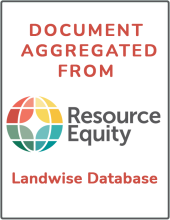Land Library Search
Through our robust search engine, you can search for any item of the over 73,000 highly curated resources in the Land Library.
If you would like to find an overview of what is possible, feel free to peruse the Search Guide.
/ library resources
Showing items 1 through 9 of 378.Previous field research on the Horqin Sandy Land (China), which has suffered from severe desertification during recent decades, revealed how land use on a sand-dune topography affects both land degradation and restoration.
Local forest management is essential for enhancing the sustainability of both communities’ livelihoods and Reducing Emissions from Deforestation and Land Degradation (REDD+) projects.
Physical activity (PA) promotes healthy life and contributes to sustainable development.
Facing widespread poverty and land degradation, Vietnam started a land reform in 1993 as part of its renovation policy package known as “Doi Moi”. This paper examines the impacts of improved land tenure security, via this land reform, on manure use by farm households.
Despite years of study and substantial investment in remediation and prevention, soil erosion continues to be a major environmental problem with regard to land use in India and elsewhere around the world. Furthermore, changing climate and/or weather patterns are exacerbating the problem.
Sandy desertification is one of the most severe ecological problems in the world. Essentially, it is land degradation caused by discordance in the Social-Ecological Systems (SES).
Unsustainable farming practices such as shifting cultivation and slash-and-burn agriculture in the humid tropics threaten the preservation of the rainforest and the health of the local and global environment.
The Reducing Emissions from Deforestation and Forest Degradation program, or REDD+, has been the international community’s first real attempt to create a global forest governance system which would impact countries on national, regional and even local scales.



